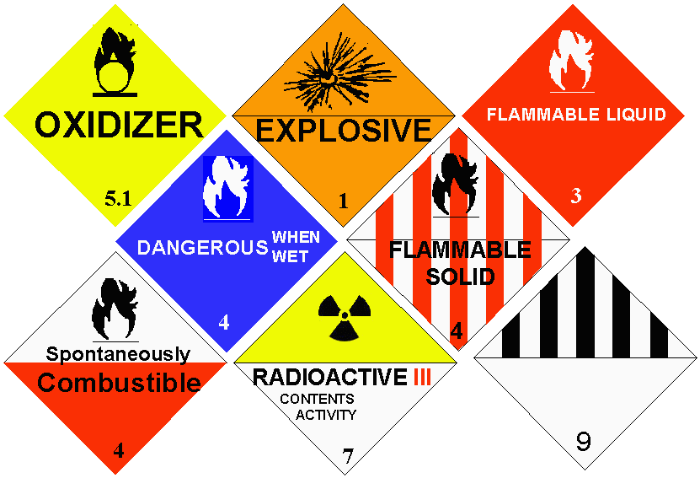There’s a lot to think about when it comes to international and domestic shipping, from paperwork issues to warehousing concerns. After all, that’s why so many people hire logistics providers to do their work for them! One obstacle that shippers frequently face is how to transport hazardous materials, or “hazmat,” across the country or overseas.
The Department of Transportation’s Definition of “Hazardous Material”
The Department of Transportation defines a hazardous material as “a substance or material capable of posing an unreasonable risk to health, safety, or property when transported in commerce.” That’s a pretty broad definition and potentially covers a wide range of shipments.
Other federal agencies, such as the FDA and OSHA, have their own definitions. Because of the range of ways to define “hazardous,” you should expect the unexpected when shipping goods. Diving sticks, perfumes, baby rattles, bouncers, doll accessories, computer parts, flashlights, and many other seemingly harmless consumer products all have the potential to be labeled as hazmat.
The 6 General Categories of Hazmat
Hazmat generally consists of six categories of products: explosives, flammable items, corrosive materials, marine pollutants, poisonous chemicals, and radioactive materials. Successfully shipping such goods requires an involved process that includes separate lists of potentially dangerous cargo and frequent inspections. You can check out more about shipping hazmat by reading our chemical products page.
A lot of hazardous materials are pretty obvious. For example, many cleaning chemicals are flammable, transmission fluid is considered a marine pollutant, and some paint sludges are poisonous. But there are other products that you might never think are “hazardous.”
The most shocking hazardous material?
The title of “Most Shocking Hazardous Material” may be awarded to Coca Cola concentrate. That’s right – the concentrated form of the delicious soda you know and love is actually considered hazardous during shipping! There are some obvious problems we all know about, like the potential consequences from consuming too much sugar. But Coca Cola concentrate can cause a host of other issues.
The most common risks you run from contact with this product are eye and skin irritation and respiratory inflammation. Because of the concentration of phosphoric acid and ethyl alcohol in the beverage, it’s important for people handling the concentrate to protect any open cuts, avoid repeated skin contact, and avoid inhaling the substance.
Is caffeine toxic?!
There’s an even more surprising risk with transporting Coca Cola concentrate, however. In addition to the chemicals already mentioned, the pure caffeine in the product is actually considered toxic. Although the Coca Cola Company maintains that there is not enough caffeine present in the concentrate to induce any harmful effects, it is nonetheless listed as a dangerous material under the OSHA definition.
Ingestion of too much pure caffeine can cause excitement, insomnia, dizziness, palpitations, headaches, and vomiting. The risk is high enough that people who ingest more than one gram are often recommended to seek prompt medical treatment.
It’s always safe to check the regulations on multiple federal agencies’ websites to make sure you’re not missing anything as you prepare chemicals or other products for shipment. And of course, you can always call up your friendly neighborhood logistics provider to get advice from the experts.






7 Comments on “Shipping Hazmat: Shocking Hazardous Materials”
This blog is more informative and induce me to know more about it.
Hi Absanasheela – we are glad you enjoyed it, thanks for reading!
All Coca Cola Product is made in concentrate form now days not the coke syrup like in the days before the 1990s it is hauled in tractor trailers in fifty five gallon drums and is corrosive ,flammable in theses drums they used to haul it in there own trucks but now they hide it from the public hauling it down the highways in common carriers without cokes name on the trucks I know this because I hauled millions of tons of it for Coke Usa as a coke driver, now i know why they got rid of us so the public would not know what is in the coke products Corrosive all the loads are leaving there Browns Mill plant placard flammable.Corrosive that is what Coke products are made from now days not like they old coca cola, and that is a fact
Hello Jerry, we are glad you enjoyed our post, thank you for sharing your experience with us.
Yeah that certainly reads like it was written by a truck driver
It was interesting to learn about how hazardous materials have a broad definition that changes according to federal agencies, and harmless products can be labeled as hazmat. I can understand how a business could be more productive when their products are shipped safely. Getting some help from a professional could allow their system to be more effective.
In the flammable liquids & gasses DPSSD course for fire fighter training. Our instructor showed us what happens if you introduce fire to concentrated mountain dew syrup. He poured at most 1/4 cup into a tin dish on the ground.. took a huge step back & tossed in the match. Flames shot up 3 maybe 4 feet in the air… IM TALKING MORE FLAMABLE THAN THE DIESEL FUEL TO TRANSPORT IT!